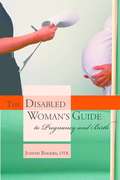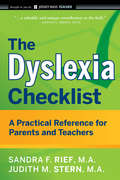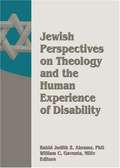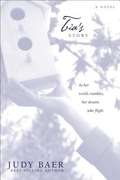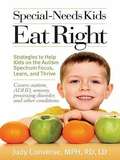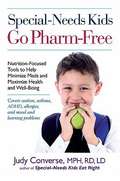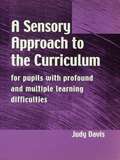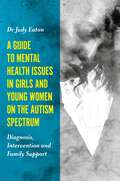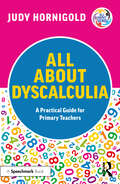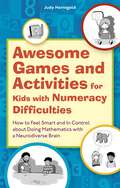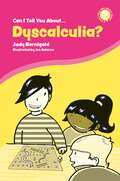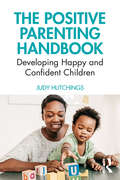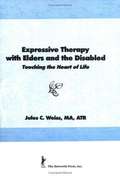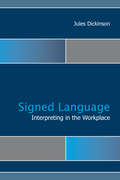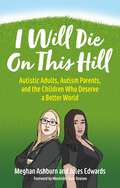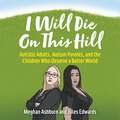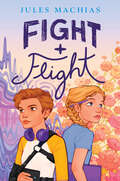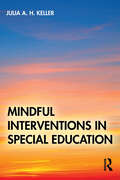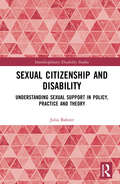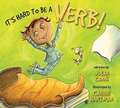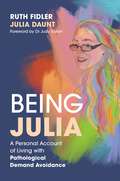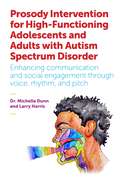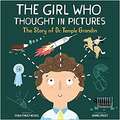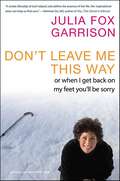- Table View
- List View
The Disabled Woman's Guide to Pregnancy and Birth
by Judith RogersThe Disabled Woman's Guide to Pregnancy and Birth is a comprehensive and useful guide that is based on the experiences of women with disabilities who chose to have children. Thoroughly researched and informative, this book is a practical guide for both disabled women planning for pregnancy, and the health professionals who work with them.
The Dyslexia Checklist
by Sandra F. Rief Judith Stern M.A.Essential advice and resources for helping kids with dyslexiaThe Dyslexia Checklist is a valuable guide for parents and teachers that can help them better understand children and teenagers with dyslexia and other reading- and language-based disabilities. The book relays the most current research available and is filled with practical strategies, supports, and interventions. Using these tools teachers and parents can accommodate the needs and strengthen the skills of students with reading and writing disabilities across all age levels. The book is presented in a simple, concise, easy-to-read checklist format and is filled with useful advice and information on a wide range of topics.Explains what we now know about dyslexia from decades of researchContains games to strengthen a child's literacy and language skillsProvides important information for hooking in reluctant and struggling readersOffers suggestions for enhancing skills in vocabulary, comprehension, composition and written expression, spelling, math, and moreThe book also provides information on the educational rights of students with dyslexia.
Jewish Perspectives on Theology and the Human Experience of Disability
by Judith Z. Abrams William C. GaventaFew people are untouched by the issue of disability, whether personally or through a friend or relative. Jewish Perspectives on Theology and the Human Experience of Disability shares moving insights from around the world and across the broad spectrum of Judaism on how and why the Jewish community is incomplete without the presence and participation of the disabled. Authors representing each of the three main movements of Judaism--Orthodox, Conservative, and Reform--examine theology, scripture, ethics, practical theology, religious education, and personal experience to understand and apply the lessons and wisdom of the past to issues of the present.
Special-Needs Kids Eat Right
by Judy ConverseGood news for parents of special- needs kids: a proven approach to everyday meals that fosters learning and development. Any parent of a child with autism, Asperger's, ADHD, sensory processing disorder, or other developmental disabilities knows that special-needs kids often have food sensitivities and can be very fussy eaters. Plus, they've been told to avoid such common ingredients as gluten and casein, making it even harder to give them the balanced, healthy meals all children need. Now, Judy Converse, a registered, licensed dietitian, offers new advice and guidance on how to use food as an essential tool for development. Based on the latest research, Special-Needs Kids Eat Right includes: bull; Simple substitutions that can be easily customized to suit any child's needs bull; Advice for helping the whole family-along with school staff and caregivers-adjust and take part bull; Strategies and tips for staying on track at restaurants, holiday gatherings, school parties and lunches, and overcoming obstacles bull; Shopping and resource guides bull; A long-term program for measuring progress and making adjustments
Special-Needs Kids Go Pharm-Free
by Judy ConverseAdvice for parents interested in nutrition strategies for enhanced health and less dependence on medications for special-needs children. This expert and practical guide advises parents of special-needs children on how to maximize the impact of nutrition in order to lessen the need for pharmaceuticals. Informed by the latest research and the author's thriving nutrition-for-kids practice, it presents condition- specific information on how to harness the power of specific foods, ingredients, and nutritional supplements to help special needs kids enjoy improved health, growth, functional ability, and well being. Suitable for children with ADHD, asthma, allergies, chronic inflammatory conditions, autism, learning disabilities, mood concerns, sensory processing disorder, and other neurodevelopmental problems. A non-invasive and holistic approach that complements existing therapies, this book aims to help each child reach his or her full potential. .
A Sensory Approach to the Curriculum: For Pupils with Profound and Multiple Learning Difficulties
by Judy DavisWritten by a teacher with many years of experience with pupils with PMLD, this book offers a well-tried approach to delivering the curriculum, with particular emphasis on the core subjects. It aims to complement and supplement existing material and provides a useful resource for busy teachers.
A Guide to Mental Health Issues in Girls and Young Women on the Autism Spectrum: Diagnosis, Intervention and Family Support
by Judy EatonThis book addresses the specific mental health needs of girls and young women with autism spectrum disorder (ASD). Looking at the ways autism presents differently in girls than in boys, and the mental health conditions that occur most frequently in girls with ASD, this is the essential guide for clinicians and educators on tailoring interventions and support to meet girls' needs. Describing the current assessment process for autism diagnosis, the book explains why girls are under- or mis-diagnosed, leading to later mental health issues. It outlines the types of intervention that are particularly helpful for working with girls to reduce anxiety, improve social interaction skills, and manage self-harm. The book also covers how to manage eating disorders and feeding difficulties, focusing on working with girls with sensory processing difficulties. There is advice on how to deal with the emotional impact on parents, carers and families, and the challenges they face when negotiating appropriate psychological and educational support.
All About Dyscalculia: A Practical Guide for Primary Teachers (All About SEND)
by Judy HornigoldAll About Dyscalculia is an accessible and informative guide for primary school teachers, designed to increase their knowledge and understanding of dyscalculia and provide practical strategies and advice to build the self-esteem and motivation of learners in their care. The book explores the indicators of dyscalculia, before detailing a range of teaching strategies that will support dyscalculic children and help them to develop their mathematical understanding and resilience. Throughout the book, there is an emphasis on creating an empathetic learning ethos in the classroom and school that will minimise maths anxiety and lead to a more positive outcome for all learners. All About Dyscalculia includes: A comprehensive introduction to dyscalculia and steps to help teachers identify children with dyscalculia in their classrooms. Practical strategies for building specific maths abilities, as well as broader problem-solving skills. Advice for teachers and parents on how to reduce maths anxiety and support the development of maths proficiency in learners. Easy to dip in and out of chapters with worked examples make this book accessible to all teachers and parents. With suggestions for immediate impact, as well as ideas for more detailed interventions, this practical book will be essential reading for all mainstream primary teachers and SENCOs, as well as a helpful guide to supporting children with dyscalculia at home.
Awesome Games and Activities for Kids with Numeracy Difficulties: How to Feel Smart and In Control about Doing Mathematics with a Neurodiverse Brain
by Judy HornigoldHas maths ever made you feel anxious, confused or like you just don't get it? This is an entertaining collection of mathematical games and curiosities for you to astound your family and friends with. You don't have to follow the chapters in a certain order - you can use this book however you would like, whether you want to get creative, play a game or impress your friends with a clever trick.Designed to spark a child's enthusiasm for maths and make learning simple, this book will help children to grasp the fundamental concepts in maths through exploration and play. This book will appeal to all learning styles and abilities but is particularly relevant for those with specific learning difficulties such as dyscalculia. Building self-esteem and promoting a growth mindset, these activities will help readers to effortlessly develop their number skills, empowering even the least confident learner with a deeper understanding of maths.
Can I Tell You About Dyscalculia?: A Guide for Friends, Family and Professionals (Can I tell you about...?)
by Judy HornigoldSam is a young boy with Dyscalculia, a lifelong condition that affects a person's ability to process numbers. It is now often compared to the way in which children with dyslexia struggle to process words. Written and illustrated from Sam's perspective, this is an excellent guide for helping children aged 7+ to understand and navigate Dyscalculia. Identifying signs, symptoms and co-occurence in child-friendly terms, Sam's story provides children with the reassurance and encouragement they need to seek help at home and at school. It also provides practical and powerful techniques for overcoming their symptoms, building self-confidence and achieving great success in life. For parents and teachers, it builds awareness around the profound and often crippling effect that Dyscalculia can have on various aspects of a child's day-to-day life, including their relationships with friends and family. It includes invaluable guidance on how to help at home and at school, as well as an extensive list of resources for those seeking additional support.
The Positive Parenting Handbook: Developing happy and confident children
by Judy HutchingsDrawing on Judy Hutchings many years of work with parents and children, The Positive Parenting Handbook is a concise, straightforward guide that offers simple solutions to daily dilemmas. The clear and easy advice provides parents with skills and tools that support positive parent/child relationships for happy and confident children. It explains common behaviour problems in young children and offers expert advice on: -How to build strong bonds and let children know they are important to you -How to encourage behaviour we want to see through praise and small rewards -Giving instructions that children are more likely to follow -How ignoring some unwanted behaviours can be helpful -Strategies for managing difficult behaviour -Teaching new behaviour to our children -Developing children’s language. It includes six case studies of how these strategies have helped real families with everyday problems at bedtime and mealtimes, during toilet training, out shopping and when children experience anxiety. Together with suggestions of other useful books and information sources, The Positive Parenting Handbook is ideal for all parents, including those of children with diagnosed developmental difficulties, and the range of professionals who work with them.
Save Me! A Young Woman's Journey through Schizophrenia to Health
by Judy LeeThe author describes growing up with an alcoholic mother and plunging into the drug culture during her years as a college student. After several LSD trips she found herself losing touch with reality, and was diagnosed as a paranoid schizophrenic. With the help of a "reality therapist" and her deep Christian faith she finally managed to rebuild her life.
Expressive Therapy with Elders and the Disabled: Touching the Heart of Life
by Jules C. WeissA classic book on the use of expressive therapies with uncommunicative elders and the disabled. This poignant guide explores group and individual therapeutic activities that promote creativity, self-expression, communication, and understanding of one's life. An experienced art therapist relates his insights into the psychosocial dynamics of elders and the disabled and shares his awareness of the sensitivity and understanding required to reach the "unreachable. " Health care workers will find this illustrated volume rich in therapeutic techniques and processes applicable to the care and growth of psychologically and physically disabled or minimally handicapped adults and elders.
Signed Language Interpreting in the Workplace
by Jules DickinsonThe last forty years have seen a dramatic change in the nature of work, with deaf people increasingly moving into white collar or office-based professions. The rise of deaf professionals has led to employment opportunities for signed language interpreters across a variety of workplace settings, creating a unique set of challenges that require specialized strategies. Aspects such as social interaction between employees, the unwritten patterns and rules of workplace behavior, hierarchical structures, and the changing dynamics of deaf employee/interpreter relationships place constraints upon the interpreter’s role and interpreting performance. Jules Dickinson’s examination of interpreted workplace interactions is based on the only detailed, empirical study of this setting to date. Using practitioner responses and transcripts of real-life interpreted workplace interactions, Dickinson’s findings demonstrate the complexity of the interpreter’s role and responsibilities. The book concentrates on the ways in which signed language interpreters affect the interaction between deaf and hearing employees in team meetings by focusing on humor, small talk, and the collaborative floor. Signed Language Interpreting in the Workplace demonstrates that deaf employees require highly skilled professionals to enable them to integrate into the workplace on a level equal with their hearing peers. It also provides actionable insights for interpreters in workplace settings that will be a valuable resource for interpreting students, practitioners, interpreter trainers, and researchers.
I Will Die On This Hill: Autistic Adults, Autism Parents, and the Children Who Deserve a Better World
by Meghan Ashburn Jules EdwardsThere is a significant divide between autistic advocates and parents of autistic children. Parents may feel attacked for their lack of understanding, and autistic adults who offer insight and guidance are also met with hostility and rejection. Meghan Ashburn, a mother of two autistic boys, and Jules Edwards, an autistic parent, were no strangers to this tension and had an adversarial relationship when they first met. Over time, the two resolved their differences and are now co-conspirators in the pursuit of disability justice. This book unites both perspectives, exploring the rift between these communities and encouraging them to work towards a common goal. It provides context to dividing issues, and the authors use their experience to illustrate where they've messed up, where they've got things right, and what they've learned along the way.
I Will Die On This Hill: Autistic Adults, Autism Parents, and the Children Who Deserve a Better World
by Meghan Ashburn Jules EdwardsA call-to-action for anyone involved in the autism community - especially autistic people and non-autistic parents - to learn from one another and achieve more together.There is a significant divide between autistic advocates and parents of autistic children. Parents may feel attacked for their lack of understanding, and autistic adults who offer insight and guidance are also met with hostility and rejection. Meghan Ashburn, a mother of two autistic boys, and Jules Edwards, an autistic parent, were no strangers to this tension and had an adversarial relationship when they first met. Over time, the two resolved their differences and are now co-conspirators in the pursuit of disability justice. This book unites both perspectives, exploring the rift between these communities and encouraging them to work towards a common goal. It provides context to dividing issues, and the authors use their experience to illustrate where they've messed up, where they've got things right, and what they've learned along the way. (P)2023 Hodder & Stoughton Limited
Fight + Flight
by Jules MachiasJules Machias, author of Indie Next List Pick Both Can Be True, delivers another inspiring story about how an unexpected friendship transforms the lives of two middle schoolers.Avery Hart lives for the thrill and speed of her dirt bike and the pounding thump of her drum kit. But after she’s diagnosed with hypermobile Ehlers-Danlos syndrome, a disease that affects her joints, Avery splits her time between endless physical therapy and worrying that her fun and independence are over for good.Sarah Bell is familiar with worry, too. For months, she’s been having intense panic attacks. No matter how much she pours her anxiety into making art, she can’t seem to get a grip on it, and she’s starting to wonder if she’ll be this way forever.Just as both girls are reaching peak fear about what their futures hold, their present takes a terrifying turn when their school is seemingly attacked by gunmen. Though they later learn it was an active shooter drill, the traumatic experience bonds the girls together in a friendship that will change the way they view their perceived weaknesses—and help them find strength, and more, in each other.
Mindful Interventions in Special Education
by Julia A. KellerBridging the gap between theory and practice, Mindful Interventions in Special Education helps aspiring educators develop their intervention toolkit. Covering topics from dyslexia to hypoactivity, each chapter provides an overview of the theoretical and research-based rationale alongside an illustrative case study for each intervention being discussed. Each intervention features mindful and strength-based remediation strategies and reflection questions to deepen readers’ understanding. Addressing a wide array of common scenarios, this thoughtful resource is ideal for anyone seeking to effectively build inclusive classrooms and support students’ social-emotional learning.
Sexual Citizenship and Disability: Understanding Sexual Support in Policy, Practice and Theory (Interdisciplinary Disability Studies)
by Julia BahnerWhat does ‘sexual citizenship’ mean in practice for people with mobility impairments who may need professional support to engage in sexual activity? The book explores this subject through empirical investigation based on case studies conducted in four countries – Sweden, England, Australia and the Netherlands – and develops the abstract notion of ‘sexual citizenship’ to make it practically relevant to disabled people, professionals in disability services and policy-makers. Through a cross-national approach, it demonstrates the variability of how sexual rights are understood and their culturally specific nature. It also shows how the personal is indeed political: states’ different policy approaches change the outcomes for disabled people in terms of support to explore and express their sexualities. By proposing a model of sexual facilitation that can be used in policy development, to better cater to disabled service users’ needs as well as furthering the theoretical understanding of sexual rights and sexual citizenship, this book will be of interest to professionals in disability services and policy-makers as well as academics and students working in the following subject areas: Disability Studies, Sociology, Social Policy, Sexuality Studies/Sexology, Social Work, Nursing, Occupational Therapy and Public Health.
It's Hard To Be A Verb!
by Julia Cook<p>Louis is a verb <p>He has a lot of trouble focusing and he is always doing something, but the problem is usually it's the wrong something. <p>It's hard to be a verb <p>My knees start itching, my toes start twitching, my skin gets jumpy, others get grumpy. <P><P> When it comes to sitting still it's just not my deal. <p>Haven't you heard. . . <p> I am a verb <p>His mom teaches him how to focus by showing him a few hands on ideas that anyone can try. <P>A must have book for all who struggle with paying attention
Being Julia - A Personal Account of Living with Pathological Demand Avoidance
by Ruth Fidler Julia DauntDiagnosed with Pathological Demand Avoidance (PDA) at aged 12 and writing this memoir at age 37, Julia Daunt depicts the ins and out of PDA and its symptoms, while maintaining a positive outlook on what is possible to achieve. Co-written with professional specialist Ruth Fidler, it covers how PDA impacts Julia's life, including meltdowns, sensory issues and communication in relationships.Including examples of school reports and handwritten letters, a chapter written from Julia's partner's perspective and even an example of Julia's favourite recipe, this warm and personal look at living and thriving with PDA is informative and inspiring.
Prosody Intervention for High-Functioning Adolescents and Adults with Autism Spectrum Disorder: Enhancing communication and social engagement through voice, rhythm, and pitch
by Michelle Dunn Larry Harris Julia DunnProviding lessons for prosody intervention in high-functioning adolescents and young adults with Autism Spectrum Disorder (ASD), this book helps to develop verbal and nonverbal skills to aid their transition into adulthood through a program of evidence-based lessons and resources. The authors offer a complete curriculum of lessons taking student from self-calming to fluency and conversational skills and thereby enhancing their communication skills and conversational competence, skills that are essential for the ability to get on in adult life, for example in the context of looking for a job. The curriculum includes lesson plans, handouts and homework, and builds on some of the characteristic traits of high-functioning autism, for example by setting up sets of rules for clarity. The program has been successfully used by the authors in their work with people on the autism spectrum and will be a life-changing resource for professionals as well as for parents and people on the autism spectrum wanting to improve their ability to communicate well.
The Girl Who Thought In Pictures The Story of Dr. Temple Grandin
by Julia Finley MoscaWhen young Temple was diagnosed with autism, no one expected her to talk, let alone become one of the most powerful voices in modern science. Yet, the determined visual thinker did just that. Her unique mind allowed her to connect with animals in a special way, helping her invent groundbreaking improvements for farms around the globe!
Don't Leave Me This Way: Or When I Get Back on My Feet You'll Be Sorry
by Julia Fox GarrisonJulia Fox Garrison refused to listen to the professionals she called Dr. Jerk and Dr. Panic, who—after she suffered a massive, debilitating stroke at age thirty-seven—told her she'd probably die, or to Nurse Doom, who ignored her emergency call button. Instead she heeded the advice of kind, gifted Dr. Neuro, who promised her he would "treat your mind as well as your body." Julia figured if she could somehow manage to get herself into a wheelchair, at least she'd always find parking. But after many, many months of hospitalization and rehab—with the help of family, friends, and her own indomitable spirit—Julia not only got into a wheelchair, but she got back out.Don't Leave Me This Way is the funny, inspiring, profoundly moving true story of a woman's fight for her life and dignity—and her determined quest to awaken an entrenched, unfeeling medical community to the fact that there's always a human being inside every patient.
